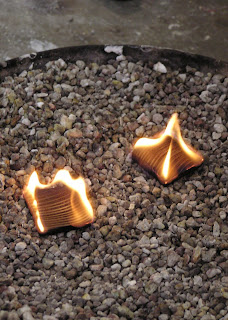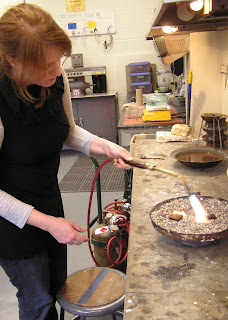
T
his project has been my very own white whale for an embarrassing number of years. It all started when I read anthropologist Simon Bonner's study of elderly woodcarvers in Pennsylvania, The Carver's Art: Crafting Meaning from Wood. Bonner's subjects were mostly retired laborers, looking for a way to way to reestablish social bonds, identity, and a sense of validity in the absence of a professional context. In ways that I found very moving, many of these men create a new niche for themselves as "trick" carvers, producing mind-boggling items such as chains, "Crown of Thorns", caged balls, and pliers. While some of the guys just carved as a solo hobby, others became demonstrators at local museums and fairs, where their abilities were justifiably appreciated. I mean, it takes a pretty jaded fairgoer not to be impressed by a guy who can turn a matchstick into a tiny, fully articulate chain. When I read the book I was headed to Penland to teach my first ever wood jewelry class. I needed an ego boost and something to wow my students; "A-ha!" I remember thinking, "I'll whip out a wooden chain; that should impress them." The diagram included in Bonner's book made it look about as hard as connecting A to B. Here's the general principle: imagine a chain compressed and arranged so that each link is oriented perpendicular to its neighbors (the cross-section looks like a +); links A and C are butting up against each other in the middle of link B; to transform the rigid plank into a wriggly chain, "simply" cut away the material between the links.It was vastly simpler to diagram than to do, which leads me to my long-standing beef with the majority of craft ethnographies: they're rich in detail on everything but the practical minutiae of the craft. Over the years, I've spent a lot of time trying to learn how to do odd things from such books and have almost always found that key information is missing, glossed over, or just plain wrong. When I started to pursue anthropology and my own ethnographic studies, my suspicions that many researchers don't bother to learn the technique they're writing about were largely confirmed. Does this matter to anyone but a craft nerd who sees every craft ethnography as a potential how-to book? I think it should. When an author fails to grasp and/or attend to the very details that a craftsperson has spent years mastering, I can't help but question the validity of the ethnography's other observations and conclusions. How things are made matters, and resonates throughout an object's lifetime (for example, consider the different associations you have with a homemade chocolate-chip cookie and a Chips Ahoy).But back to the chain. That "simple" matter of removing the wood between the links turned into a 3-year ordeal (admittedly, I made things harder on myself by choosing to make a graduated chain, fatter in the middle than at the ends). The trick I came up with (which might or might not have been used by Bonner's informants--who knows?) is a little harrowing: carve away as much wood between the links as you possibly can, using successively smaller tools, then hold your breath and snap the remaining wood (not the links themselves, ideally). Once the links are free you can work them around to get at the leftover splinters with your knife.
Having freed the final link, I was unable to put my not-quite-finished chain aside. That same night I fastened it (pencil marks, bloodstains and all) around my neck with a handmade padlock, and headed off to an event at the Seattle Art Museum. At the museum I joined an informal tour led by Dan Webb, a fantastically talented Seattle-based carver whose work is in the SAM collection. When I approached Webb afterwards to compliment him on his work, he asked me about the chain. I went red and started to stammer that it wasn't finished, wasn't very good, etc. Webb stopped me: "I've carved a few chains, and that is a good chain."
Maybe there's something to the notion of establishing an identity through trick carving after all.










































